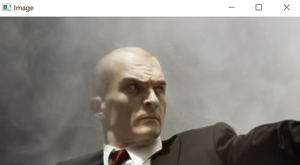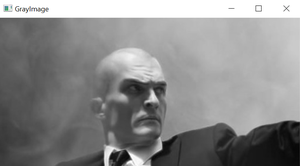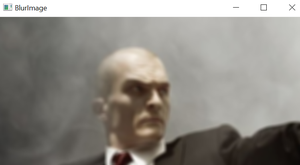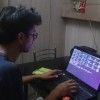OpenCV C++ Program to blur an image
Last Updated : 19 Dec, 2022
The following is the explanation to the C++ code to blur an Image in C++ using the tool OpenCV.
Things to know:
(1) The code will only compile in Linux environment.
(2) Compile command: g++ -w article.cpp -o article `pkg-config –libs opencv`
(3) Run command: ./article
(4) The image bat.jpg has to be in the same directory as the code.
Before you run the code, please make sure that you have OpenCV installed on your system.
// Title: OpenCV C++ Program to blur an image. // Import the core header file #include <opencv2/core/core.hpp> // core - a compact module defining basic data structures, // including the dense multi-dimensional array Mat and // basic functions used by all other modules. // highgui - an easy-to-use interface to video // capturing, image and video codecs, as well // as simple UI capabilities. #include <opencv2/highgui/highgui.hpp> // imgproc - an image processing module that // includes linear and non-linear image filtering, // geometrical image transformations (resize, affine // and perspective warping, generic table-based // remapping) color space conversion, histograms, // and so on. #include <opencv2/imgproc/imgproc.hpp> // The stdio.h header defines three variable types, // several macros, and various functions for performing // input and output. #include <stdio.h> #include <iostream> // Namespace where all the C++ OpenCV functionality resides using namespace cv; using namespace std; // We can also use 'namespace std' if need be. int main() // Main function { // read the image data in the file "MyPic.JPG" and // store it in 'img' Mat image = imread("bat.jpg", CV_LOAD_IMAGE_UNCHANGED); // Mat object is a basic image container. // imread: first argument denotes the image to be loaded // the second arguments specifies the image format. // CV_LOAD_IMAGE_UNCHANGED (<0) loads the image as is // CV_LOAD_IMAGE_GRAYSCALE ( 0) loads the image as an // intensity one // CV_LOAD_IMAGE_COLOR (>0) loads the image in the // BGR format // If the second argument is not specified, it is // implied CV_LOAD_IMAGE_COLOR // Check for no data if (! image.data ) { cout << "Could not open or find the image.\n"; return -1; // unsuccessful } // Function to blur the image // first argument: input source // second argument: output source // third argument: blurring kernel size blur(image,image,Size(10,10)); // Create a window // first argument: name of the window // second argument: flag- types: // WINDOW_NORMAL If this is set, the user can resize the // window. // WINDOW_AUTOSIZE If this is set, the window size is // automatically adjusted to fit the // displayed image() ), and you cannot // change the window size manually. // WINDOW_OPENGL If this is set, the window will be // created with OpenGL support. namedWindow( "bat", CV_WINDOW_AUTOSIZE ); // Displays an image in the specified window. // first argument: name of the window // second argument: image to be shown(Mat object) imshow( "bat", image ); waitKey(0); // Wait infinite time for a keypress return 0; // Return from the main function } To Run the program in the Windows, VISUAL STUDIO you can use following approach:
The idea is to first use a function called cvtColor to convert the input image into Grayscale image, then we will convert that Grayscale image to Blurred Image using a function GaussianBlur.
SYNTAX:
cvtColor(source_image, destination_image, code);
GaussianBlur(source_image, destination_image, kernel-size, sigmaX);
PARAMETERS:
cvtColor is the in-built function in the C++ that is used to convert one color space(number of channels) to another using the color space conversion code. Color space conversion code are easily accessible and are pre-defined. You can learn more about them over here.
GaussianBlur takes Grayscale image as input and returns a blurred image.
Kernel size is used to define how much we want the kernel to affect the pixels in our image. Now kernel is the matrix of pixels in the image, so when we define kernel size it will first pickup an anchor(a center point) and then it will affect the pixels in its neighborhood. In a 3*3 matrix only the neighborhood pixel’s will be affected while in a 10*10 matrix will affect the pixels in range of 10*10 matrix from the center.
SigmaX: A variable of the type double representing the Gaussian kernel standard deviation in X direction.
Implementation of the above approach.
C++
#include <iostream>
#include <opencv2/highgui.hpp>
#include <opencv2/imgcodecs.hpp>
#include <opencv2/imgproc.hpp>
using namespace std;
using namespace cv;
void main()
{
string path = "Resources/face.jpeg";
Mat img = imread(path);
Mat imgGray, Blur_img;
cvtColor(img, imgGray,
COLOR_BGR2GRAY);
GaussianBlur(img, Blur_img, Size(7, 7), 5,
0);
imshow("Image", img);
imshow("GrayImage",imgGray);
imshow("Blurimg", Blur_img);
waitKey(0);
}
|
OUTPUT:

Original image
GrayScale Image:

GrayImage
Blur Image:

Blurred Image
OpenCV Python Program to Blur Image
About the Author:
Aditya Prakash is an undergraduate student at Indian Institute

of Information Technology, Vadodara. He primarily codes in C++. The motto for him is: So far so good. He plays cricket, watches superhero movies, football and is a big fan of answering questions.
If you also wish to showcase your blog here, please see GBlog for guest blog writing on GeeksforGeeks.
Similar Reads
OpenCV C++ Program to blur a Video
The following is the explanation to the C++ code to blur a video in C++ using the tool OpenCV. Things to know: (1) The code will only compile in Linux environment. (2) To run in windows, please use the file: 'blur_video.o' and run it in cmd. However if it does not run(problem in system architecture)
3 min read
OpenCV C++ Program to create a single colored blank image
The following is the explanation to the C++ code to create a single colored blank image in C++ using the tool OpenCV. Things to know:Â (1) The code will only compile in Linux environment. (2) To run in windows, please use the file: 'blank.o' and run it in cmd. However if it does not run (problem in
3 min read
OpenCV - Blur image
In this article, we will learn how to Blur an image using Python OpenCV. [GFGTABS] Python </p><pre><code class="language-python3"># Python Program to blur image import cv2 # bat.jpg is the batman image. img = cv2.imread('bat.jpg') # make sure that you have saved i
2 min read
Python OpenCV | cv2.blur() method
OpenCV-Python is a library of Python bindings designed to solve computer vision problems. cv2.blur() method is used to blur an image using the normalized box filter. The function smooths an image using the kernel which is represented as: Syntax: cv2.blur(src, ksize[, dst[, anchor[, borderType]]]) Pa
2 min read
OpenCV C++ Program to play a video
The following is the explanation to the C++ code to play a video in C++ using the tool OpenCV. Things to know: (1) The code will only compile in Linux environment. (2) To run in windows, please use the file: 'play_video.o' and run it in cmd. However if it does not run(problem in system architecture)
3 min read
OpenCV Python Program to analyze an image using Histogram
In this article, image analysis using Matplotlib and OpenCV is discussed. Let's first understand how to experiment image data with various styles and how to represent with Histogram. Prerequisites: OpenCVmatplotlibImporting image data import matplotlib.pyplot as plt #importing matplotlib The image s
4 min read
Python | Image blurring using OpenCV
Image Blurring refers to making the image less clear or distinct. It is done with the help of various low pass filter kernels. Advantages of blurring: It helps in Noise removal. As noise is considered as high pass signal so by the application of low pass filter kernel we restrict noise. It helps in
2 min read
OpenCV | Saving an Image
This article aims to learn how to save an image from one location to any other desired location on your system in CPP using OpenCv. Using OpenCV, we can generate a blank image with any colour one wishes to. So, let us dig deep into it and understand the concept with the complete explanation. Code :
3 min read
Cpp14 Program to Turn an image by 90 degree
Given an image, how will you turn it by 90 degrees? A vague question. Minimize the browser and try your solution before going further. An image can be treated as 2D matrix which can be stored in a buffer. We are provided with matrix dimensions and it's base address. How can we turn it? For example s
4 min read
Reading an image in OpenCV using Python
Prerequisite: Basics of OpenCV In this article, we'll try to open an image by using OpenCV (Open Source Computer Vision) library.  Following types of files are supported in OpenCV library: Windows bitmaps - *.bmp, *.dibJPEG files - *.jpeg, *.jpgPortable Network Graphics - *.png WebP - *.webp Sun ras
6 min read